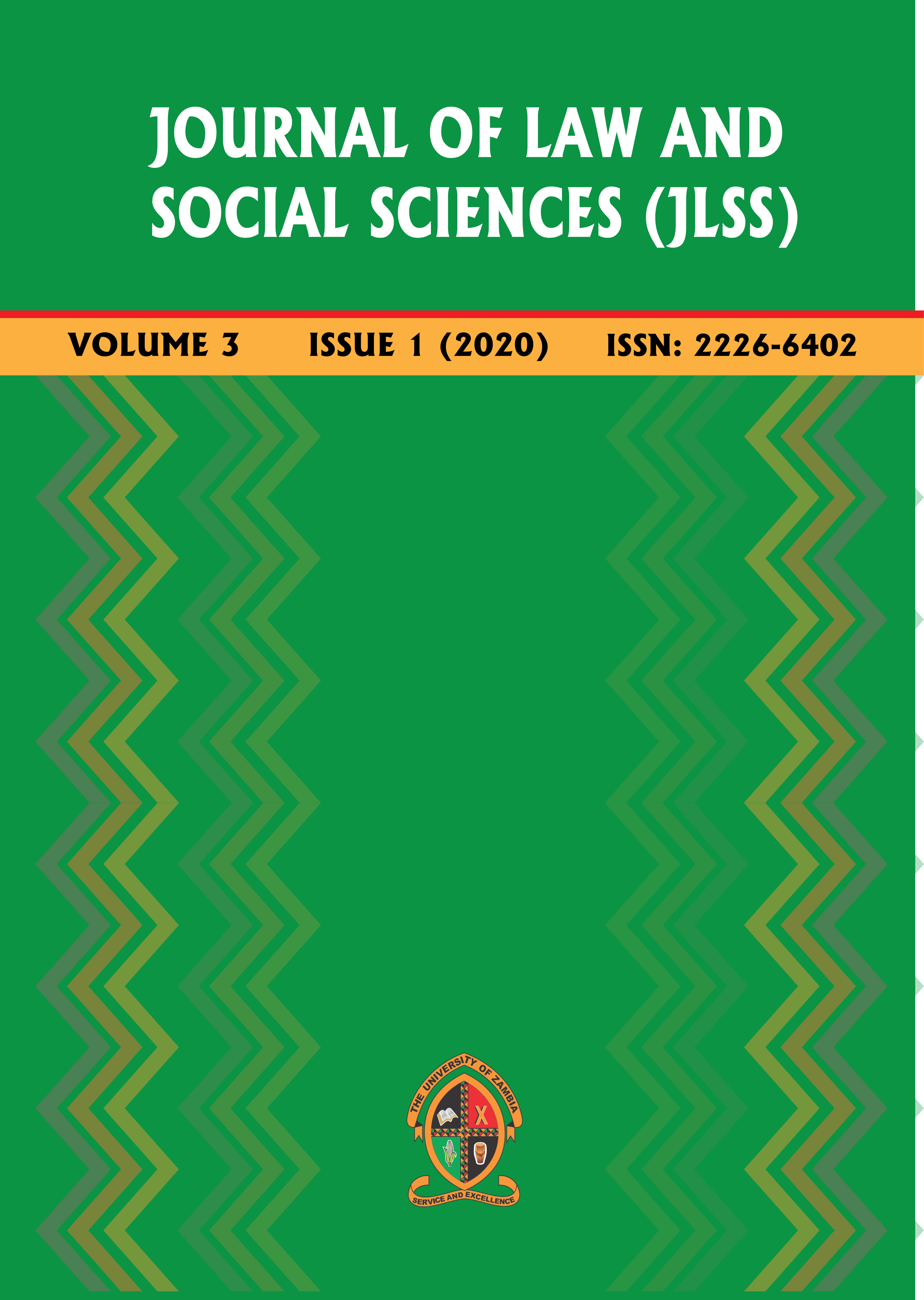The Tonga Art of Kulibanda: A Literary and Linguistic Analysis
Keywords:
Kulibanda, Politeness Principle, Rematerialisation, Tonga Arts,, Onomastics, Kuyabila, Clan Name, Translanguaging, Verbal Art, Excremental Vision, Speech Act Theory, Imagery
Abstract
Framed within the broader context of two not so related theoretical lenses – literary theory and linguistic theory – the paper seeks to characterise Tonga practice of kulibanda as a language-based artistic expression for its sociocultural, literary and linguistic significance among the Tonga people. Couched within Austin’s speech act theory, Levison’s politeness principle and literary theory, this brief assessment attempts to bring into the spotlight unique characteristics of kulibanda, which in ordinary speech would be judged as flouting the maxims of politeness, deference and cultural appropriateness. Having considered the material potency of kulibanda collected from online platforms and occurring in real-life situation, it is insightful to conclude that the artistic clamour, stylistic flexibility and the linguistic sensibilities of kulibanda transform this piece of art beyond its traditional theoretical enclave of oral literature into the structured linguistic materiality for a shared sociocultural knowledge, histories and meaning making enterprise among the Tonga people.References
1. Austin, J.L. (1962). How to Do Things with Words. London: Oxford University Press.
2. Bach, K., and Harnish, R.M. (1982). Linguistic Communication and Speech Acts. The MIT Press.
3. Bach, K. (2014). ‘Speech Acts,’ in Speech Acts. Routledge Encyclopedia of Philosophy, n.d. Web 10, Feb 2012.
4. Barnet, S. et al., (2004). An Introduction to Literature. New York: Pearson.
5. Bascom, W.R. (1955). ‘Verbal Art’ in The Journal of American Folklore, 68, 269: 245-252.
6. Bauman, R. (1975). ‘Verbal Art as Performance’ in American Anthropologist, New Series, 77, 2: 290-311.
7. Chilala, C. (2010). The Cultural Factor in the Semiotics of Modern African Drama. Lusaka: University of Zambia. Unpublished Thesis.
8. Chilala, C.H.K. ‘Dorika’s Metamorphosis: The Allusive Potency of a Comic Character’ in Chukwumah, I. (Ed.) (2018) Joke-Performance in Africa: Mode, Media and Meaning. London and New York: Routledge.
9. Colson, E. (2006). Tonga Religious Life in the Twentieth Century. Lusaka: Bookworld Publishers.
10. Cuddon, J.A. (1991). Dictionary of Literary Terms and Literary Theory. London: Penguin Books Ltd.
11. Guthrie, M. (1967). Comparative Bantu. An Introduction to Comparative Linguistics and the Pre-history of Bantu Languages. 4 Volumes. Farnborough: Gregg Press.
12. Jimaima, H. (2016). Social Structuring of Language and the Mobility of Semiotic Resources Across Linguistic Landscapes in Zambia: A Multimodal Analysis. Unpublished PhD Thesis. University of the Western Cape.
13. Kress, G. (2010). Multimodality: A Social Semiotic Approach to Contemporary Communication. New York: Routledge.
14. Leech, N.G. (1983). Principles of Pragmatics. California: Longman.
15. Levison, C.S. (1983). Pragmatics. Cambridge: Cambridge University Press.
16. Mukanzubo Kalinda Institute (2011). Chitonga-English Dictionary. Monze: Mukanzubo Kalinda Institute.
17. Nkolola-Wakumelo, M. (2013). ‘Names of Cattle and the Cattle-Naming System among the Tonga of Zambia,’ in Cliggett, L. and Bond, V. (Eds.) (2013) Tonga Timeline: Appraising Sixty Years of Multidisciplinary Research in Zambia and Zimbabwe. Lusaka: Lembani Trust.
18. Nyambi, O., Mangena, T., and Pfukwa, C. (eds.) (2016). The Postcolonial Condition of Names and Naming Practices in Southern Africa. Newcastle Upon Tyne: Cambridge Scholars Publishing.
19. O’Sullivan, O. (1993). English-Silozi Dictionary. Lusaka: Zambia Educational Publishing House.
2. Bach, K., and Harnish, R.M. (1982). Linguistic Communication and Speech Acts. The MIT Press.
3. Bach, K. (2014). ‘Speech Acts,’ in Speech Acts. Routledge Encyclopedia of Philosophy, n.d. Web 10, Feb 2012.
4. Barnet, S. et al., (2004). An Introduction to Literature. New York: Pearson.
5. Bascom, W.R. (1955). ‘Verbal Art’ in The Journal of American Folklore, 68, 269: 245-252.
6. Bauman, R. (1975). ‘Verbal Art as Performance’ in American Anthropologist, New Series, 77, 2: 290-311.
7. Chilala, C. (2010). The Cultural Factor in the Semiotics of Modern African Drama. Lusaka: University of Zambia. Unpublished Thesis.
8. Chilala, C.H.K. ‘Dorika’s Metamorphosis: The Allusive Potency of a Comic Character’ in Chukwumah, I. (Ed.) (2018) Joke-Performance in Africa: Mode, Media and Meaning. London and New York: Routledge.
9. Colson, E. (2006). Tonga Religious Life in the Twentieth Century. Lusaka: Bookworld Publishers.
10. Cuddon, J.A. (1991). Dictionary of Literary Terms and Literary Theory. London: Penguin Books Ltd.
11. Guthrie, M. (1967). Comparative Bantu. An Introduction to Comparative Linguistics and the Pre-history of Bantu Languages. 4 Volumes. Farnborough: Gregg Press.
12. Jimaima, H. (2016). Social Structuring of Language and the Mobility of Semiotic Resources Across Linguistic Landscapes in Zambia: A Multimodal Analysis. Unpublished PhD Thesis. University of the Western Cape.
13. Kress, G. (2010). Multimodality: A Social Semiotic Approach to Contemporary Communication. New York: Routledge.
14. Leech, N.G. (1983). Principles of Pragmatics. California: Longman.
15. Levison, C.S. (1983). Pragmatics. Cambridge: Cambridge University Press.
16. Mukanzubo Kalinda Institute (2011). Chitonga-English Dictionary. Monze: Mukanzubo Kalinda Institute.
17. Nkolola-Wakumelo, M. (2013). ‘Names of Cattle and the Cattle-Naming System among the Tonga of Zambia,’ in Cliggett, L. and Bond, V. (Eds.) (2013) Tonga Timeline: Appraising Sixty Years of Multidisciplinary Research in Zambia and Zimbabwe. Lusaka: Lembani Trust.
18. Nyambi, O., Mangena, T., and Pfukwa, C. (eds.) (2016). The Postcolonial Condition of Names and Naming Practices in Southern Africa. Newcastle Upon Tyne: Cambridge Scholars Publishing.
19. O’Sullivan, O. (1993). English-Silozi Dictionary. Lusaka: Zambia Educational Publishing House.
Published
2020-09-30
How to Cite
Chilala, C. and Jimaima, H. (2020) “The Tonga Art of Kulibanda: A Literary and Linguistic Analysis”, Journal of Law and Social Sciences, 3(1), pp. 160-177. doi: https://doi.org/10.53974/unza.jlss.3.1.450.
Section
Humanities
